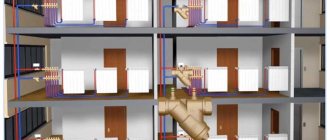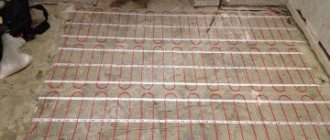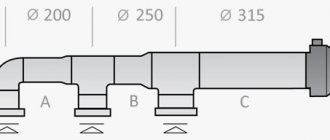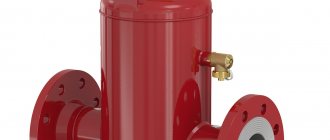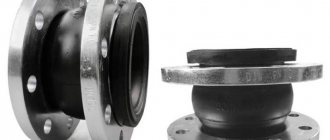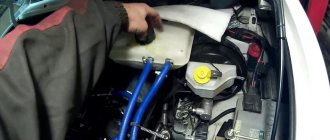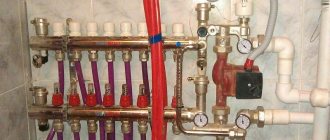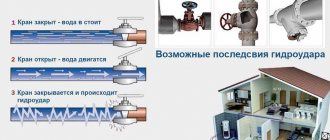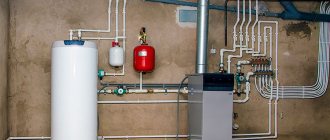One of the most common problems in functioning heating systems is airing, which leads to uneven heating of radiators or underfloor heating pipes. To combat this negative phenomenon, air vents for heating systems operating in different modes are widely used.
Using an air vent installed at the inlet of the heat exchange devices, air is released from the heating circuits. There are various types of air vents on the market, in order to understand the wide range of models and choose the right device for an individual heating system, you should know the operating principle, existing types and design features of manufactured air vents.
Rice. 1 Air vents
What are air vents and what are they for?
Many owners of radiator systems have encountered a situation where, with hot pipes, some parts of the radiator do not heat well or are generally cold; similar problems arise with insulation with water floors. The main reason for this phenomenon is the presence of air in the pipes, which rises up and impedes the movement of the coolant.
If there is a large volume of air, a plug may form, leading to a complete stop of coolant circulation in the pipeline - the line becomes air-filled.
If in an open circuit air bubbles are sent to an unclosed expansion tank located on high floors of a building or attic, and bleeding is not so important, then in a closed system an air bleeder for the heating system is vital on all circuits and individual heat exchange devices.
When plugs interfere with the operation of the system, manual or automatic heating drain valves are used to remove accumulated air. One of the simplest devices is a regular valve installed at the top point of heating radiators. To bleed air from the batteries, open the valve and wait for the moment when the stream stops flowing jerkily along with the air - in radiators without air, the water flow will be uniform.
In individual heating lines of private houses, instead of ordinary valves, special locks are installed on the radiators, which function automatically or are manually adjusted. With their help, they remove not only air from devices in which gas formation occurs, but also, when necessary, oxygen from water, which causes accelerated corrosion of metal fittings.
Rice. 2 Air vent for venting air from the heating system - design
Design and operating principle
The automatic air valve for heating systems has a simple and reliable design. The hollow metal body is equipped with a connecting pipe, which is located at the bottom or side, depending on the version of the product. In the inner chamber of the device there is a float made of polymer resin. The float is connected by a lever rod to a needle valve that closes the hole in the upper part of the air vent cover.
When removing the plug using a manual valve, you need to control the process in order to shut off the device in time - the air will be completely released when a trickle of coolant flows through the vent. Installing an automatic air vent eliminates the hassle of servicing the heating system.
The operating principle of the device is based on the use of gravity - a hollow float is lighter than water, but heavier than air. In the normal state, the air extractor is filled with coolant, due to which the float is in the upper position, pressing the needle valve. Over time, the coolant is displaced from the internal chamber of the device by accumulating gas.
As a result, the float falls down under the influence of gravity, opening the valve slightly. The accumulated air under the pressure of the liquid in the heating system comes out through the hole in the drain body, and the chamber is again filled with coolant, which raises the float, automatically closing the valve.
Float ventilators serve to remove air pockets and also help speed up the draining of coolant from the system during maintenance or repair work. Due to a decrease in the coolant level in the circuit, the valves automatically open, and the air entering through them causes the liquid to drain faster.
Reasons for airing the system
Air in the heating circuit negatively affects the function and durability of the system. Oxygen reacts with steel and causes corrosion. Air locks interfere with the normal movement of the coolant, blocking the heating of the upper part of the radiators or entire heating devices. The presence of air bubbles in the coolant leads to premature wear of the moving parts of circulation pumps.
Air-filled heating system
There are several reasons for the formation of air jams
:
- Using water from a water supply system as a coolant that has not undergone special treatment to remove dissolved air. When heated, gases leave the liquid medium and accumulate at the upper points of the pipeline and batteries.
- Excessively fast filling of the system with coolant or its supply is not from the lowest point. In such a situation, the liquid does not have time to displace air from all corners of the installed system.
- Loss of system tightness due to installation errors or damage to elements.
- The use of polymer pipes that do not have a barrier coating, which prevents the penetration of oxygen molecules into the coolant.
- Errors when developing a project or arranging a system (incorrectly chosen angle of inclination of pipes, etc.).
- Air entering the system during repairs that require dismantling circuit elements.
Air vents for heating systems - operating principle
To bleed air from the circuit, you can use a regular valve by draining a certain amount of liquid. If in communal houses a decrease in the volume of water in the circuit does not cause negative consequences and it is replenished by utility services, then in individual houses the drained coolant will have to be replenished independently.
For a closed system, adding coolant is quite a big problem - you will have to connect a manual or electric pump, and if there is toxic ethylene glycol antifreeze in the line, carrying out the work while taking the necessary safety measures will take a lot of time.
The main difference between special air vent devices and conventional valve locks is the small diameter of the outlet hole, its location at an angle of 90 degrees and the ability to smoothly adjust the cross-section of the outlet channel with a threaded screw.
As can be seen from Fig. 2, the screw has a cone-shaped shape and a similar seat, thanks to which, when closed, it reliably and hermetically covers the inlet hole. To bleed air, the screw head is turned one or two turns, opening a small-diameter outlet drain hole, and the air-filled coolant along with bubbles will begin to flow out of the tap in small quantities while the air plug will be released more intensively.
The advantage of using an air vent is that when you turn the screw, first of all, with a characteristic hissing sound, the air flow comes out, and then the aired coolant flows out, a small amount of which does not need to be added to the system.
Fig.3 Operating principle of an automatic air vent
Types of Automatic Air Valves
Types of devices
Based on their design, devices are divided into three types.
Straight traditional
The most common vent valves are those with direct connection. They are used to bleed air at the highest points of the pipeline. To do this, they are installed at the top in vertical risers.
Corner
Instead of a conventional valve, corner structures can be installed to automatically release the air lock from the heating system. This type of equipment is most relevant if there are always gases in the line, especially in the radiator section.
Special for radiators
Radiator-type devices are designed specifically for installation directly on batteries. For this purpose they have a threaded connection. Such valves are mounted on aluminum and bimetallic radiators, on those devices that come into contact with water. In this case, installation of a radiator device is necessary.
How do air vents for heating systems work?
The cold coolant poured into the heating line tends to release air when heated; to bleed it, automatic air release from the heating system is used.
The operating principle of all automatic devices is to open the bleed hole when air appears in the internal area of the air vent housing. The element that reacts to the presence of air is a float immersed in the inlet pipe of the device, which is connected to a valve that closes the air outlet hole. The automatic device works according to the following principle (Fig. 3):
- When the heating is functioning normally, the float located in the space of the cylindrical working chamber is in the upper position and the cone-shaped rod connected to it closes the outlet channel.
- If air accumulates in the upper part of the tank, the float goes down along with the locking rod and the air valve opens, air is released from the device.
Rice. 4 Automatic air release valve from the heating system
Device
There are various designs of automatic air bleed valves on the market; let’s look at the design and operation of one of the most common types.
This model (Fig. 4.) has a composite body made of brass, including the main part 1, which is screwed into the pipeline, and its cover 2 with a locking mechanism, connected to the base through an o-ring 10.
Recommendations for choosing an air valve
Theoretically, an automatic air release valve can be installed in all necessary places. But in practice, the scope of application of automatic machines is limited for many reasons. For example, the design of the Mayevsky crane is simpler and has no moving parts, so it is more reliable. The manual tap is a cylindrical body made of plumbing brass with external threads. There is a through hole made inside the housing, the passage in which is blocked by a screw with a conical end.
A round calibrated channel extends from the main hole located in the center. When you unscrew the screw between these two channels, a message appears, causing air to leave the system. During operation, the screw is completely tightened, and to release gases from the system, it is enough to unscrew it a couple of turns with a screwdriver or even by hand.
In turn, an automatic air valve is a hollow cylinder, inside of which there is a plastic float. The operating position of the device is vertical, the internal chamber is filled with coolant entering through the lower hole under the influence of pressure in the system. The float is mechanically attached to the needle release valve by means of a lever. Gases coming from the pipelines gradually displace water from the chamber and the float begins to descend. As soon as the liquid is completely displaced, the lever will open the valve and all the air will quickly leave the chamber. The latter will immediately be filled with coolant again.
The internal moving parts of the automatic air release gradually become covered with scale, and the working openings become silted. As a result, the mechanism jams, gases come out slowly, and water begins to flow through the assembly with the needle. This type of air release valve is easier to replace than to repair. Hence the conclusion: car air vents are installed only in those places where it is impossible to do without them. They are selected for:
- boiler safety groups where the coolant temperature is the highest;
- the highest points of vertical risers, where all gases rise;
- distribution manifold for underfloor heating, where air from all heating circuits accumulates;
- loops of U-shaped expansion joints made of polymer pipes, turned upward.
When choosing a device, you should pay attention to 2 parameters: maximum operating temperature and pressure. If we are talking about a heating scheme for a private house up to 2 floors high, then, in principle, any automatic valve for releasing air will do. The minimum parameters of air vents offered on the market are as follows: operating temperature up to 110 ºС, pressure range in which the device operates effectively - from 0.5 to 7 Bar.
In high-rise cottages, circulation pumps can develop higher pressure, so when selecting, you need to focus on their performance. As for the temperature, in private residential networks it rarely exceeds 95 ºС.
Advice. Experts and practitioners recommend purchasing car air vents with an exhaust pipe directed upwards. According to reviews, a device with a side exit begins to leak much more often. In addition, during installation it is necessary to strictly observe the vertical position of the housing.
Manual air vents for heating systems (Mayevsky taps) are most often accepted for installation on radiators. Moreover, many manufacturers of sectional and panel appliances complete their products with taps for gas removal. In this case, there are 3 types of air vents according to the method of unscrewing the screw:
- traditional, with slots for a screwdriver;
- with a rod in the form of a tetrahedron or other shape for a special key;
- with a handle for manual unscrewing without any tools.
Advice. The third type of product should not be purchased for a home where preschool children live. Accidentally opening the tap can lead to serious burns from the hot coolant.
Types of air vents and their design features
There are air vent valves of automatic and manual operating principles, the former are mainly installed at the top points of collectors and pipelines, manual modifications (Mayevsky valves) are placed on radiator heat exchangers.
Automatic devices are distinguished by a wide variety of designs for locking mechanisms; their cost is in the range of 3 - 6 USD; the market offers a wide range of models from domestic and foreign manufacturers. The cost of standard Mayevsky taps is about 1 USD; there are products at a higher price, designed to function in non-standard radiator heaters.
Rice. 6 Air vents for heating systems with a rocker mechanism
Automatic
Automatic tappers have different designs depending on the manufacturer; the main differences between the devices are:
- The presence of a reflective plate inside the body. It is placed at the entrance to the working chamber, protecting internal parts from hydraulic shocks.
- Many modifications are supplied complete with a spring shut-off valve into which the air vent is screwed; when it is removed, the spring is compressed and the O-ring closes the outlet channel.
- Some models of automatic diverters are designed for operation in conjunction with radiator heat exchangers; instead of straight ones, they have side threaded pipes of the appropriate size for screwing into the radiator inlet. If necessary, corner automatic air vents of any type can be used, for example, at the connection points of heated floor circuits, hydraulic arrows, if their threaded diameters of the inlet and outlet fittings match.
- There are analogues of air vents on the market - microbubble separators; they are mounted sequentially in the pipeline on two inlet pipes corresponding to the diameter of the pipes. When liquid passes through the body tube with a soldered copper mesh, a vortex water flow is created, which inhibits the dissolved air - this promotes the rise of tiny air bubbles, which are released through the automatic air release valve of the chamber.
- Another common design (an example of the first was given above) is a model with a rocker mechanism. In the chamber of the device there is a float made of plastic; it is connected to a nipple locking needle (like a car one). When the float is lowered in an airy environment, the nipple needle opens the drain hole and air is released; when the water rises and the float rises, the needle closes the outlet.
Rice. 7 Operating principle of separator-type air vents for bleeding microbubbles
Manual
Manual devices for removing air from the system are called Mayevsky valves; due to the simplicity of their design, mechanical air vents are universally installed on radiators. On the market you can find manual taps in a traditional design for installation in various places, and some modifications of shut-off valves are equipped with Mayevsky taps.
The Mayevsky cranes produced do not differ in a wide variety due to their simple design, consisting of a body with an air duct bent at 90 degrees and a cone-shaped locking screw.
A mechanical vent for removing air from a heating system works as follows:
- In operating mode, the conical screw is tightened and reliably seals the outlet hole of the housing.
- When it is necessary to remove excess air from the battery, make one or two turns of the screw - as a result, the air flow under coolant pressure will come out of the side hole.
- After the air is released, the water begins to bleed out; as soon as the water stream becomes intact, the screw is screwed in again and the de-airing operation is considered complete.
How the device works
An air valve (or several) is installed in the heating system, in places where air bubbles are most likely to accumulate. This prevents the formation of a large traffic jam and the heating operates uninterruptedly.
We recommend that you read: Types of steel fittings and features of their installation
Mayevsky crane
Such devices are named after the name of their developer. The Mayevsky tap has a thread and dimensions for a pipe with a diameter of 15 mm or 20 mm. It's structured simply:
- There are 2 through holes made in the body of the valve body, which in the open position of the Mayevsky tap communicate with the heating system.
- These holes are closed by a threaded screw with a conical tip.
- Air is released through a small (2 mm) hole directed upward.
In order to bleed air from the system, unscrew the screw 1.5-2 turns. The air escapes with a whistle as the communications are under pressure. The end of the air plug exit is characterized by a drop in pressure and the appearance of water.
Note! The Mayevsky crane is a simple and reliable device for bleeding off air accumulations. It does not clog or break because it has no moving parts. Its design is simple and reliable.
On the market you can find several varieties of the Mayevsky tap, which are identical in design, but differ in the way they regulate the shut-off screw. There are:
- with a convenient handle for unscrewing by hand;
- with a regular head for a flat screwdriver;
- with a square head for a special key.
For an adult, the principle of unscrewing the locking screw does not matter. However, in a house where there are children, it is safer to use devices that should be unscrewed with a special tool. By unscrewing a regular tap with a comfortable handle, a child can be scalded by boiling water.
Automatic crane
The automatic air release valve is designed on the principle of a float chamber, the design includes:
- vertical housing with a diameter of 15 mm;
- float inside the housing;
- a spring valve with a cover, which is connected and adjusted by a float.
The automatic air valve for the heating system operates without human intervention. In normal condition, when there is no air in the system, the float is pressed by the pressure of the liquid filler to the valve cover. The lid is tightly closed.
We recommend that you read: How to build a plasterboard box yourself to disguise pipes in a toilet?
As air accumulates in the valve body, the float moves down. As soon as it drops to a critical level, the spring valve opens and bleeds air out. Under the pressure of the carrier in the system, the space is again filled with liquid. The float rises, closing the spring valve cover.
When there is no coolant in the communications, the float lies at the bottom of the valve. As the system fills, air comes out of the tap in a continuous stream until the coolant reaches the float.
Note! A small amount of air is constantly present under the automatic faucet lid. This is the norm and does not affect work in any way.
The following configurations of automatic air valves for heating are distinguished:
- with vertical air discharge;
- with side air discharge (through a special jet);
- with bottom connection;
- with corner connection.
For an amateur, the design features of an automatic crane do not matter. However, for a professional there is a difference in choosing between devices.
It is believed that:
- a device with a jet and a side hole is more reliable in operation than an automatic valve with vertical air discharge;
- a bottom-mounted valve traps air bubbles more effectively than a side-mounted valve.
If the design of the Mayevsky crane has not undergone changes for many years, the design of automatic valves is constantly being improved and supplemented.
Manufacturers offer automatic valves with additional devices:
- with a membrane to protect against water hammer;
- with a shut-off valve for easy dismantling of the device during the heating season;
- mini valves.
Note! The disadvantage of an automatic valve is its rapid contamination. Scale and debris clog the internal, moving parts of the device. This leads to a weakening of its efficiency or complete failure.
Automatic heating air valves require frequent inspection and cleaning. The undoubted advantages of these devices include the ability to install them in hard-to-reach places.
Where should air vents for heating systems be installed correctly?
When installing a heating system, installing air vents is a mandatory procedure; to determine the required quantity, you need to know where to place these devices. Air vents are recommended to be located in the following places:
- The highest points of the system. If during installation the pipeline rises upward, bypassing any obstacle, and then descends down to the heat exchangers, an automatic air vent for the heating system should be installed on top. This will prevent airing due to the fact that light air always rises and accumulates in the pipeline on the upper floor.
Rice. 9 Types of automatic air vents
- Heating radiators. Radiator heat exchangers have a complex shape, including a large number of sections - this creates convenient cavities for air accumulation. Therefore, Mayevsky outlet valves are always used in radiators; in an individual heating circuit, they are installed on each radiator, regardless of the connection diagram (one-pipe, two-pipe, bottom, side, diagonal). Radiator manual models of exhaust valves, unlike automatic ones, are small in size, less expensive, fit aesthetically into the radiator contour, and therefore are installed on batteries in the vast majority of cases by the manufacturer and, if necessary, by home owners.
- Heated towel rails. Industrially produced heated towel rails of the complex “ladder” shape, popular in everyday life, are always equipped with an air vent with a straight pipe located in its upper part. It is more convenient if the heated towel rail is equipped with an automatic air vent for the following reasons: the screw located at the top of the manual model is inconvenient to tighten, in residential buildings there may be periodic lack of water and manual adjustment becomes troublesome, in addition, the duct protruding from the side spoils the aesthetic appearance of the heater.
- U-shaped bends and bypasses. Any section of a pipeline with an upward-facing loop collects air; if a shut-off valve is used to turn off the loop, it is installed at the highest point, using a model with a built-in automatic Mayevsky valve (naturally, the air vent at the top can be installed separately from the valve).
- Boiler piping system. It is also recommended to equip the boiler piping with a valve to ensure safe operation of the heating equipment in the event of airing in the main line.
- Hydroshooters. It is not so often that in household heating systems they use hydraulic arrows, to which circulation pumps, radiator and heated floor collectors are connected - if the device is located vertically, an automatic air bleeder is screwed into its upper part.
- Collectors. When installing multi-circuit heated floors, manifolds with combs are used, to which the pipeline of various circuits is connected. The collectors are located above the level of the water floors and are always equipped with automatic air vents, which are installed in their housing by the manufacturer; the system includes two devices for the supply and return lines.
Rice. 10 Manual and automatic air vents for heating systems - location diagram
Types of automatic air vents
Depending on the manufacturing option, the automatic float air vent can be straight, angular or radiator. Models differ in appearance and installation location, but the principle of air bleed is the same.
Devices with straight connection
A straight air vent is the most popular version of the device, since it is suitable for installation on the upper ends of vertical risers, on underfloor heating manifolds, as part of a safety group, on circulation pumps. Using a tee, it can be cut into a problem section of the pipeline if a small slope angle provokes the occurrence of air pockets.
Design of a direct automatic air vent with a pipe
Radiator and corner models
The corner air vent is designed for installation in hard-to-reach places. For example, due to the pipe located on the side of the housing, the device can be connected to the threaded end of a horizontal pipeline of a dead-end branch of the heating system. If necessary, corner automatic air vents in the heating system can be used instead of straight ones.
Instead of a Mayevsky manual tap, standard corner automatic drain valves can be installed on radiators to remove frequently occurring air pockets from radiators. However, a more rational approach is to use special radiator automatic air vents. This model also has an angular design, but differs from the standard one in its threaded design - it is suitable for connecting the device directly to the radiator, without using an adapter.
Technical specifications
Air vents for heating systems operating in automatic mode have different connecting diameters. Russian heating systems use devices with 1/2” and 3/4” threaded connections. The most common thread is 1/2”, which is also known as DN15 (connecting size is 15 mm).
The following characteristics are also taken into account when choosing:
:
- operating pressure (standard 10 atm, there are models with an indicator of 16 atm);
- operating temperature of the environment (standard up to 110-120°C);
- type of threaded connection - external or internal thread.
Pay attention to the case material. Reliable devices are made from high-quality plumbing brass
Silumin products are characterized by increased fragility.
Technical data of automatic air vent
Any heating system air vent with the required thread type is suitable for a home with an autonomous heating supply.
It is more difficult to select a device for radiators connected to the central heating network - it is important to check with the housing department or other organization responsible for the house the operating parameters of the system
Design of a ball valve with a drain valve
| Designation in the figure | Component name | Material |
| 1 | Hull part | Nickel plated brass |
| 2 | O-ring | Fluoroplastic |
| 3 | Closing ball | Chrome plated brass |
| 4 | Connecting segment | Nickel plated brass |
| 5 | Sealed top stem | Fluoroplastic |
| 6 | O-ring | Rubber |
| 7 | Sealed bottom part of the stem | Fluoroplastic |
| 8 | Sealing nut | Uncoated brass |
| 9 | Stock | Uncoated brass |
| 10 | Nut fixing the handle | Steel |
| 11 | Handle | Steel |
| 12 | Drain valve | Brass |
| 13 | Sealing element | Fiber |
Advice: it is recommended to invite experienced plumbers to install drain valves, since the instructions for performing this process are quite complex, and the slightest inaccuracy can lead to depressurization of the entire heating system.
Samples with a hose nozzle are available. This greatly simplifies the process of draining the liquid, since it is easy to direct the flow through a hose into a bucket or even a bottle.
Another addition is the possibility of installing a pressure gauge, which will allow you to measure the pressure in the circuit.
Principle of operation
A ball valve with a bleeder functions as follows:
- We turn the handle by hand.
- This movement is transmitted through the rod to the check ball.
- The metal ball has a through hole in the middle and rotates under the action of the rod until it coincides with the hole in the outlet pipe.
- The valve allows the air space to be released without moving the entire structure.
Tip: It is recommended to use only the fully open and fully closed handle positions. If you open the ball only halfway, this will lead to breakage of the product and rapid wear.
Although the price of the device is not much higher than that of a simple device, deaeration under such conditions is much simpler. Let's look at the conditions in which it needs to be carried out:
When to use the release valve
- First of all, upon completion of the installation of the heating system. There will definitely remain air space in the pipes of the heating system, and in a closed circuit it will not be able to escape anywhere except under the influence of high pressure.
- At the end of each summer period during which the heating was turned off. The fact is that a certain amount of air is necessarily present in the coolant, and during such a long period of no circulation it manages to accumulate in the upper layers of the pipeline.
- In addition, the appearance of a plug may be provoked by corrosion processes, during which a large amount of hydrogen is formed. This especially applies to aluminum heating radiators, in which, upon prolonged contact with the coolant, the described chemical reaction begins.
